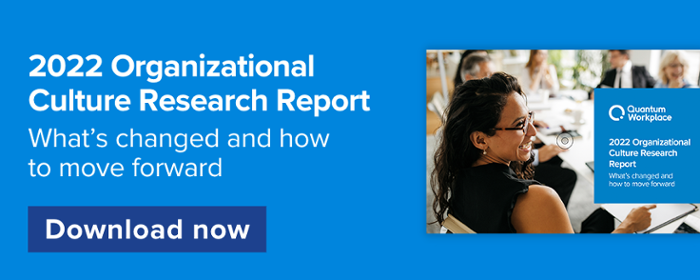Measuring Company Culture: What, Why, and How
 Company culture has changed considerably over the last couple of years and it hasn’t gone unnoticed to employees. In fact, 1 in 3 employees say their culture has changed dramatically in the past two years. This change will likely continue whether you’re investing in culture or not. To guide change in the right direction, leaders need to keep a pulse on their culture.
Company culture has changed considerably over the last couple of years and it hasn’t gone unnoticed to employees. In fact, 1 in 3 employees say their culture has changed dramatically in the past two years. This change will likely continue whether you’re investing in culture or not. To guide change in the right direction, leaders need to keep a pulse on their culture.
The importance of measuring culture
If you’re not measuring culture, it will be difficult to understand and improve. Your culture data can help you:
- Uncover deep & actionable insights into the current state of your culture
- Understand obstacles and opportunities
- Know where and when to focus
- Communicate better with more context at your fingertips
- Align teams around your efforts and your goals
- Build a more inclusive culture
- Improve engagement, performance, and retention
How culture can lead to improved business outcomes
Culture is all about how you do things within your organization. It’s about the way you communicate, give feedback, recognize employees, create alignment, and set goals. Because culture impacts your workforce everyday, it’s no surprise that it can boost employee engagement, retention, and performance.
When you focus on creating a culture that has a positive impact on engagement and performance, your employees will be better equipped to help your business succeed. Culture is not a fluffy, one-time project. It requires intention and should be shaped by data and insights.
What to measure in your culture
To create a culture that drives employee, team, and business success, you need to aim it at employee engagement. Your culture—or the way work gets done—can have a positive, negative, or neutral impact on employee engagement.
When you focus your culture strategies around improving employee engagement, culture becomes much easier to measure. It becomes much more tangible. To measure culture and engagement, you need to understand the strength of the mental and emotional connection that employees have with their work, with their teams, and with your organization.
When you understand how culture is impacting engagement, you’ll get the full picture. You can uncover culture obstacles and opportunities —and know where to focus to drive change.
What are the key culture metrics to track
Certain business metrics can tell you a lot about culture. Keep a pulse on these metrics to ensure your culture is evolving in the right ways:
Referrals
The number of employee referrals can tell you a lot about your culture. If employees regularly recommend an organization as a great place to work, they likely value their everyday experience. Tracking this metric helps you understand if you’re building the kind of culture that attracts, engages, and retains talent.
Turnover
When top performers and new hires voluntarily leave at high rates, a negative culture may be to blame. An employee’s everyday experience impacts their decision to stay or not, which is why turnover and retention rates are a top indicator of company culture.
Productivity
A positive company culture motivates employees to do their best work. If employees regularly fail to accomplish important objectives, your culture is likely hindering employee success. By keeping a pulse on productivity metrics, you can understand whether your culture motivates employees in the right ways or not.
Communication
Communication from top to bottom and across departments should be easy. Employees should feel comfortable to openly express thoughts, concerns, and feedback. But if communication regularly isn’t followed up upon or is met with negativity, your culture may be toxic. Listen to employees and understand how they communicate—it can tell you a lot about culture.
How to measure company culture
Measuring company culture is important in helping you understand what is happening inside your organization. Once you have a better understanding of how your culture is impacting the employee experience, you can make meaningful adjustments to shape it. Follow this three-step framework to measure your workplace culture.
Ask.
Start by getting feedback from your employees. It’s important to ask the right questions. These questions should help you understand employee perceptions of how work gets done. Ask employees about how common behaviors impact them, including the way you communicate, show appreciation, make decisions, and more.
Analyze.
After collecting this data, analyze your results.
- What did you uncover?
- What are the common trends?
- What’s the story?
- What might you do next to move the needle?
Act.
Once you answer these questions, it’s time to take action. Talk with employees about what you’re doing and why, and see if your changes made a difference.
Tools for measuring and improving culture
It’s important to continuously measure, iterate, and optimize culture. Tracking culture metrics gives you insight into broad feelings about culture, but you’ll need an array of tools to help you dig deeper. The right technology can help paint a full picture so you can move forward with confidence. Here’s how a robust culture platform can help.
Employee surveys
Your employees can tell you a lot about what’s working and what’s not in your culture. And employee surveys can bring these perceptions to the surface.
Here are 6 employee survey questions about culture to get started:
1. The work I do contributes to fulfilling our organization's mission.
2. I see behaviors displayed across our organization that are consistent with our company’s core values.
3. I have a good understanding of our organization’s mission, values, and goals.
4. Our organization constantly looks for ways to improve our products and services.
5. The pace of work at our organization enables employees to do a good job.
6. Our culture supports employee health and wellbeing.
Leverage engagement, lifecycle, and pulse surveys to gather real-time feedback at all points of an employee’s tenure and understand what’s happening deep within your culture. An integrated employee engagement survey platform will help you capture the employee voice and empower employees at all levels to drive their own experience.
Focus groups
Having genuine conversations with employees provides insight into company culture, shedding light on both the good and the bad. Ask for personal stories and experiences to understand culture on a deeper level. Look for common themes and trends among employees to understand the big picture.
Exit interviews
Exit interviews facilitate feedback from employees who are leaving the organization. The feedback you gather will speak volumes about what’s going wrong in your culture. Based on this feedback, you can adapt and use your culture as a tool to retain existing and future employees.
Engaging performance management tools
Our research shows an organization’s approach to performance management is one of the most powerful ways that employees experience culture. Employees need clarity and context around their performance. They want to know how they’re doing, and they want their performance to be evaluated in a fair, transparent, and engaging way. A continuous performance management platform can help employees feel aligned and included at work.
People analytics tools
It’s important to know where your culture stands at any given moment. That way, you can make improvements when needed. When you pair a thoughtful culture strategy with real-time people analytics, you can create meaningful culture change.
People analytics tools can help you uncover key culture insights with tools like performance snapshot, turnover trends, flight risk, and narrative insight. And an intelligence dashboard will bring these insights to life with custom reports and visualizations.
Syncing your people data up with your business data allows you to understand the connection between culture, engagement, retention, and business outcomes.
Ready to learn more about company culture? Download our latest report on organizational culture to move forward with confidence.







